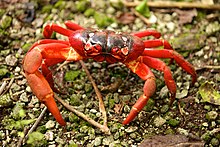Christmas Island red crab
| Christmas Island red crab | |
|---|---|

| |
| Scientific classification | |
| Kingdom: | |
| Phylum: | |
| Subphylum: | |
| Class: | |
| Order: | |
| Infraorder: | |
| Family: | |
| Genus: | |
| Species: | G. natalis
|
| Binomial name | |
| Gecarcoidea natalis Pocock, 1888
| |
The Christmas Island red crab, Gecarcoidea natalis, is a species of land crab that is endemic to Christmas Island and the Cocos (Keeling) Islands in the Indian Ocean.[1][2] Although restricted to a relatively small area, it has been estimated that 43.7 million adult red crabs lived on Christmas Island alone,[3] but the accidental introduction of the yellow crazy ant is believed to have killed about 10–15 million of these in recent years.[4] Christmas Island red crabs eat mostly fallen leaves and flowers, but will occasionally eat other animals, including other red crabs (see cannibalism) if the opportunity arises.[5]
Description
The carapace is up to 116 millimetres (4.6 in) wide,[5] rounded, and encloses the gills. The claws are usually of equal size, unless one becomes injured or detached, in which case the limb will regenerate.[5] The male crabs are generally larger than the females, while adult females have a much broader abdomen (only apparent above 3 years of age) and usually have smaller claws.[5]
Ecology
Christmas red crabs live in burrows for shelter from the sun.[5] Since they breathe through gills, the possibility of drying out is dangerous.[5] They are famous for their annual migration to the sea to lay their eggs in the ocean.[5]
Population
Early inhabitants of Christmas Island rarely mentioned these crabs. It is possible that their large population size was caused by the extinction of the endemic Maclear's Rat, Rattus macleari in 1903, which may have limited the crab's population.[6] Surveys have found a density 0.09–0.57 adult red crabs per square metre, equalling an estimated total population of 43.7 million on Christmas Island.[3] Others have estimated that about 120 million are found on this island, but the basis for that claim is unclear.[5]
An exploding population of the yellow crazy ant, an invasive species accidentally introduced to Christmas Island and Australia from Africa, is believed to have killed 10–15 million red crabs (one-quarter to one-third of the total population) in recent years.[4] In total (including killed), the ants are believed to have displaced 15–20 million red crabs on Christmas Island.[7]
References
- ^ Dennis J. O'Dowd & P. S. Lake (1990). "Red crabs in rain forest, Christmas Island: differential herbivory of seedlings". Oikos. 53 (3): 289–292. JSTOR 3545219.
- ^ A. K. Shaw (September 11, 2010). "Christmas Island Red Crabs". Princeton University, Department of Ecology and Evolutionary Biology. Retrieved June 26, 2011.
- ^ a b A. M. Adamczewska & S. Morris (2001). "Ecology and behavior of Gecarcoidea natalis, the Christmas Island red crab, during the annual breeding migration" (PDF). The Biological Bulletin. 200: 305–320. PMID 11441973.
- ^ a b Dennis J. O'Dowd, Peter T. Green & P. S. Lake (2003). "Invasional 'meltdown' on an oceanic island" (PDF). Ecology Letters. 6 (9): 812–817. doi:10.1046/j.1461-0248.2003.00512.x.
- ^ a b c d e f g h "Christmas Island Red Crabs, Gecarcoidea natalis (Pocock, 1888)". Environment Australia. Retrieved March 30, 2011.
- ^ Tim Flannery & Peter Schouten (2001). A Gap in Nature: Discovering the World's Extinct Animals. Atlantic Monthly Press, New York. ISBN 0-87113-797-6.
- ^ "Yellow crazy ants". Department of Sustainability, Environment, Water, Population and Communities. March 23, 2011. Retrieved March 30, 2011.
